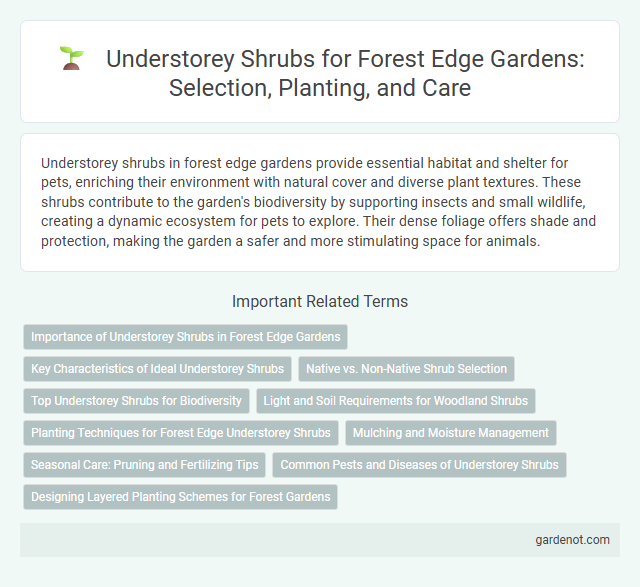Understorey shrubs in forest edge gardens provide essential habitat and shelter for pets, enriching their environment with natural cover and diverse plant textures. These shrubs contribute to the garden's biodiversity by supporting insects and small wildlife, creating a dynamic ecosystem for pets to explore. Their dense foliage offers shade and protection, making the garden a safer and more stimulating space for animals.
Importance of Understorey Shrubs in Forest Edge Gardens
Understorey shrubs play a crucial role in forest edge gardens by enhancing biodiversity and providing essential habitat for wildlife such as birds, insects, and small mammals. These shrubs contribute to soil stability and nutrient cycling, improving overall ecosystem health. Their presence also creates microclimates that support the growth of shade-tolerant plants while offering seasonal food sources through flowers, fruits, and seeds.
Key Characteristics of Ideal Understorey Shrubs
Ideal understorey shrubs for a forest edge garden exhibit shade tolerance, enabling growth beneath taller canopy trees. They possess moderate growth rates with dense foliage to provide habitat and erosion control while maintaining biodiversity. Adaptability to acidic, well-drained soils and resistance to deer browsing enhance their survival and ecosystem contribution.
Native vs. Non-Native Shrub Selection
Selecting understorey shrubs for a forest edge garden requires prioritizing native species such as spicebush (Lindera benzoin) and serviceberry (Amelanchier spp.) due to their ecological benefits and adaptability to local conditions. Native shrubs support regional wildlife, including pollinators and birds, enhance soil health, and maintain biodiversity, while non-native species may pose invasive risks or fail to provide equivalent habitat value. Choosing indigenous shrubs ensures sustainable growth, minimizes maintenance, and preserves the natural balance of forest edge ecosystems.
Top Understorey Shrubs for Biodiversity
Top understorey shrubs for biodiversity in forest edge gardens include species such as Viburnum dentatum, Cornus amomum, and Lindera benzoin, which provide essential habitat and food sources for native wildlife. These shrubs enhance ecosystem health by supporting pollinators, birds, and small mammals through dense foliage and ample fruit production. Integrating diverse understorey shrubs promotes soil stability and increases overall plant community resilience in forest edge environments.
Light and Soil Requirements for Woodland Shrubs
Understorey shrubs in forest edge gardens thrive best in partial to dappled shade, reflecting their natural woodland environment where sunlight filters through the canopy. These shrubs require well-drained, moist, and loamy soils rich in organic matter to support healthy root development and nutrient uptake. Maintaining slightly acidic to neutral soil pH ensures optimal growth and vibrant foliage for woodland shrub species.
Planting Techniques for Forest Edge Understorey Shrubs
Planting understorey shrubs at the forest edge requires selecting species adapted to partial shade and variable moisture conditions to ensure optimal growth. Techniques include preparing soil with ample organic matter to enhance nutrient availability and mulching to retain moisture and suppress weeds. Proper spacing, generally 1 to 3 meters apart depending on mature shrub size, promotes air circulation and reduces competition for light and nutrients.
Mulching and Moisture Management
Understorey shrubs in forest edge gardens benefit significantly from mulching, which conserves soil moisture and suppresses weed growth. Organic mulches like bark chips and leaf litter create a protective layer that improves water retention and enriches soil nutrients as they decompose. Effective moisture management through mulching reduces irrigation needs and promotes healthy shrub root development in fluctuating environmental conditions.
Seasonal Care: Pruning and Fertilizing Tips
Understorey shrubs in forest edge gardens thrive with seasonal pruning that removes dead or overcrowded branches to promote healthy growth and improve air circulation. Fertilize these shrubs in early spring using a balanced, slow-release fertilizer rich in nitrogen and potassium to support leaf development and root strength. Regularly monitor soil moisture and adjust fertilization to prevent nutrient deficiencies and maintain vibrant shrub health throughout the growing season.
Common Pests and Diseases of Understorey Shrubs
Understorey shrubs in forest edge gardens commonly face pests such as aphids, spider mites, and scale insects that can cause leaf distortion and reduced vigor. Diseases like powdery mildew, leaf spot, and root rot frequently affect these shrubs, leading to weakened growth and discoloration. Effective management includes regular monitoring, maintaining proper air circulation, and applying organic or chemical controls to mitigate infestations and infections.
Designing Layered Planting Schemes for Forest Gardens
Understorey shrubs in forest edge gardens enhance biodiversity by creating a multi-layered habitat that supports pollinators and wildlife. Selecting species like hazel (Corylus avellana), spirea (Spiraea spp.), and ribes (Ribes spp.) ensures year-round interest with varied foliage, flowers, and fruits. Incorporating shrubs with differing light and moisture preferences optimizes spatial use and ecological benefits in layered planting schemes.
Understorey shrub Infographic

 gardenot.com
gardenot.com